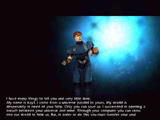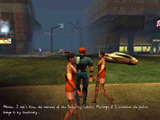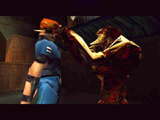 We’ve
been looking forward to Eidos’ Omikron: The Nomad Soul since we got a brief glance at
it at E3, partly because what we saw of it looked terrific, mostly because we
couldn’t quite figure out what the hell it was supposed to be--as is probably to be
expected from a game featuring David Bowie. Indeed, Eidos has billed the game as a 3D
action-adventure game, but one that incorporates "adventure, exploration, action,
combat and role playing elements." We’d heard genre-bender promises like this
about games in development before, so we were skeptical. But we’ve been playing
Omikron for the last couple of days, and lo and behold it does include all those elements.
Though we’re still not sure what the hell it is, one thing’s for sure--we
really, really, like it.
We’ve
been looking forward to Eidos’ Omikron: The Nomad Soul since we got a brief glance at
it at E3, partly because what we saw of it looked terrific, mostly because we
couldn’t quite figure out what the hell it was supposed to be--as is probably to be
expected from a game featuring David Bowie. Indeed, Eidos has billed the game as a 3D
action-adventure game, but one that incorporates "adventure, exploration, action,
combat and role playing elements." We’d heard genre-bender promises like this
about games in development before, so we were skeptical. But we’ve been playing
Omikron for the last couple of days, and lo and behold it does include all those elements.
Though we’re still not sure what the hell it is, one thing’s for sure--we
really, really, like it.  Probably the best way explain Omikron is to
address each of the game’s takes on various genres individually. First of all,
Omikron is primarily an adventure and exploration game. The game’s basic premise is
that the player suddenly finds their soul projected to a different futuristic
dimension—which is so far a sort of pastiche of Star Wars, 1984, RoboCop and Blade
Runner--and into a new body. Of course, the player has no inkling why this has happened
(and we’re not telling—in fact, we’re still not sure ourselves) and
game’s main goal is to unravel this mystery and do something about it. To accomplish
this, the player must scour four different sprawling cities—mostly in 3rd-person
view--in search of deliverance.
Probably the best way explain Omikron is to
address each of the game’s takes on various genres individually. First of all,
Omikron is primarily an adventure and exploration game. The game’s basic premise is
that the player suddenly finds their soul projected to a different futuristic
dimension—which is so far a sort of pastiche of Star Wars, 1984, RoboCop and Blade
Runner--and into a new body. Of course, the player has no inkling why this has happened
(and we’re not telling—in fact, we’re still not sure ourselves) and
game’s main goal is to unravel this mystery and do something about it. To accomplish
this, the player must scour four different sprawling cities—mostly in 3rd-person
view--in search of deliverance.
Thus far, the adventure aspect of the game seems first-rate. Given that
you have no memory, there’s plenty you’ve got to figure out—including the
local folkways. The world of Omikron is close enough to ours to seem familiar, different
enough to surprise you. Of course, you’ll soon be thrust into other, more disturbing
mysteries—mysteries involving murder and the supernatural. To solve these mysteries,
you’ll glean information from conversations with the denizens of Omikron, and they are
a kinky bunch (uh, the teen rating should probably be taken seriously). Thankfully, most
of these conversations are well-scripted and interesting. Unlike many an adventure game
(especially consoles), in which too much gets given away too soon in long-winded and
artificial dialogue, in Omikron you only gradually piece the picture together. As you go
along, you’ll collect items, which can be handily stored on your person in your SNEAK
mini-computer or cached in your Multiplan virtual locker. The game’s interface is
elegant and easy-to-use, and accessing your stuff pretty painless—although it can
sometimes be a little awkward if you’re using a gamepad to play. You’re only
allowed to save in certain points, and only allowed a certain number of saves, so you have
to be careful. This console-like save system may not be to everyone’s liking, but
thus far it hasn’t been an issue in gameplay. And of course one of the game’s
coolest features is what Eidos calls "Virtual Reincarnation." If the body that
your nomad soul inhabits is killed, your soul will automatically transmigrate into the
next person that touches the corpse. This allows players to play in several different
bodies (including that of Bowie’s supermodel wife, Iman) in each game, and each body
has different abilities.
 But
it’s not just an adventure game—it’s a first-person shooter as well!
That’s right, at certain points in Omikron, the gentle art of verbal persuasion just
won’t do the trick, and then it’s time to introduce Mr. Smith and Mr.
Wesson—er, make that Mr. Octogun—to your new-found friends. These first-person
interludes are scripted into the game, so you can’t just go around blowing everyone
away, and they’re pretty good so far. One odd thing—you’ll play most of the
game in 3rd person view, so the gamepad is a good choice for most of your
adventuring. However, once things kick—sometimes unexpectedly—into the FPS
dimension, you’ll want to switch to the tried-and-true mouse and keyboard combo. This
can make for some awkward fumbling, so keep on your toes.
But
it’s not just an adventure game—it’s a first-person shooter as well!
That’s right, at certain points in Omikron, the gentle art of verbal persuasion just
won’t do the trick, and then it’s time to introduce Mr. Smith and Mr.
Wesson—er, make that Mr. Octogun—to your new-found friends. These first-person
interludes are scripted into the game, so you can’t just go around blowing everyone
away, and they’re pretty good so far. One odd thing—you’ll play most of the
game in 3rd person view, so the gamepad is a good choice for most of your
adventuring. However, once things kick—sometimes unexpectedly—into the FPS
dimension, you’ll want to switch to the tried-and-true mouse and keyboard combo. This
can make for some awkward fumbling, so keep on your toes.
 But wait; there’s
more! Omikron is also a fighting game. That’s right, every once in a while
you’ll have to unlimber the lads and whoop up on the bad guys fistically. To this
end, Omikron has implemented a fighting system reminiscent of console fighters.
You’ll want to use the gamepad for this. At least initially, you’ll only be
aware of a few moves; as you progress in the game, you’ll learn new ones through
practice, books you can purchase, and good-old-fashioned button mashing. Though we’ve
only been playing for a while, we’re much taken with the fighting game. We’ll
see if it holds up.
But wait; there’s
more! Omikron is also a fighting game. That’s right, every once in a while
you’ll have to unlimber the lads and whoop up on the bad guys fistically. To this
end, Omikron has implemented a fighting system reminiscent of console fighters.
You’ll want to use the gamepad for this. At least initially, you’ll only be
aware of a few moves; as you progress in the game, you’ll learn new ones through
practice, books you can purchase, and good-old-fashioned button mashing. Though we’ve
only been playing for a while, we’re much taken with the fighting game. We’ll
see if it holds up.
 Finally, Omikron does
have a fairly serious RPG element to it. Your character will be rated in certain
areas—like energy, fighting, attack, dodge, resistance, and speed—and most of
attributes can be bumped up through practice and experience. You’ll have plenty of
opportunities to do this, since Omikron is dotted with virtual practice facilities. Oh,
and yet another Omikron RPG-ish element. You can cast spells as well, whose effectiveness
is influenced by your mana rating. Thus far we haven’t had much experience with this
aspect of the game, but we’ll let you know about it in our final review.
Finally, Omikron does
have a fairly serious RPG element to it. Your character will be rated in certain
areas—like energy, fighting, attack, dodge, resistance, and speed—and most of
attributes can be bumped up through practice and experience. You’ll have plenty of
opportunities to do this, since Omikron is dotted with virtual practice facilities. Oh,
and yet another Omikron RPG-ish element. You can cast spells as well, whose effectiveness
is influenced by your mana rating. Thus far we haven’t had much experience with this
aspect of the game, but we’ll let you know about it in our final review.
 Graphically, the game is outstanding; though thus far the city of Omikron
seems to be wrapped in a persistent fog—which can be seen as atmospheric in a Blade
Runner kind of way (which works for us) or just lazy graphically in a Nintendo 64 sort of
way—the world of Omikron is visually stunning. Your new dimension is just visually
wack enough to make you feel like a stranger, and just familiar enough so you can tell
that urinals are urinals—though really odd urinals. It’s sort of like being in
France. Omikron also implements such original features as facial motion capture in
real-time, and includes 3D motion-captured fighting moves modelled from real-life martial
arts champions. It also contains more than 400 different sets and 140 characters. These
characters have real character, too—there’s no lack of personality (or
personalities) in Omikron.
Graphically, the game is outstanding; though thus far the city of Omikron
seems to be wrapped in a persistent fog—which can be seen as atmospheric in a Blade
Runner kind of way (which works for us) or just lazy graphically in a Nintendo 64 sort of
way—the world of Omikron is visually stunning. Your new dimension is just visually
wack enough to make you feel like a stranger, and just familiar enough so you can tell
that urinals are urinals—though really odd urinals. It’s sort of like being in
France. Omikron also implements such original features as facial motion capture in
real-time, and includes 3D motion-captured fighting moves modelled from real-life martial
arts champions. It also contains more than 400 different sets and 140 characters. These
characters have real character, too—there’s no lack of personality (or
personalities) in Omikron.
 Ah, and the music. David
Bowie and Reeves Gabrels have created original music for the game, including eight new
songs, including "Thursday’s Child." And these are full-length songs, too;
ever since we got burned by the few short Cypress Hill songs in Kingpin, we’ve been
skeptical about this sort of thing, but Omikron has restored our faith. And though of
course your enjoyment of the tracks will be tempered by your taste in music, these are not
just take-the-money-and-run throwaways. They’re damn good tunes, especially the title
track. In the game, you’ll be able to catch Bowie’s subversive band, The
Dreamers, performing these songs in bars. You can even purchase the "virtual
album" of the music in-game, take it back to your virtual apartment, and kick back
with a virtual beverage while virtually chillin’.
Ah, and the music. David
Bowie and Reeves Gabrels have created original music for the game, including eight new
songs, including "Thursday’s Child." And these are full-length songs, too;
ever since we got burned by the few short Cypress Hill songs in Kingpin, we’ve been
skeptical about this sort of thing, but Omikron has restored our faith. And though of
course your enjoyment of the tracks will be tempered by your taste in music, these are not
just take-the-money-and-run throwaways. They’re damn good tunes, especially the title
track. In the game, you’ll be able to catch Bowie’s subversive band, The
Dreamers, performing these songs in bars. You can even purchase the "virtual
album" of the music in-game, take it back to your virtual apartment, and kick back
with a virtual beverage while virtually chillin’.
The great thing about Omikron is that—so far, at least—it takes all these
different genres and combines them in a game that we can’t stop playing. With a
compelling story, great pacing, first-person and fighting combat, state-of-the-art
graphics and Bowie’s music, we’re in this one to the bitter end. And maybe by
then we’ll have figured out just what the hell this game is.

 We’ve
been looking forward to Eidos’ Omikron: The Nomad Soul since we got a brief glance at
it at E3, partly because what we saw of it looked terrific, mostly because we
couldn’t quite figure out what the hell it was supposed to be--as is probably to be
expected from a game featuring David Bowie. Indeed, Eidos has billed the game as a 3D
action-adventure game, but one that incorporates "adventure, exploration, action,
combat and role playing elements." We’d heard genre-bender promises like this
about games in development before, so we were skeptical. But we’ve been playing
Omikron for the last couple of days, and lo and behold it does include all those elements.
Though we’re still not sure what the hell it is, one thing’s for sure--we
really, really, like it.
We’ve
been looking forward to Eidos’ Omikron: The Nomad Soul since we got a brief glance at
it at E3, partly because what we saw of it looked terrific, mostly because we
couldn’t quite figure out what the hell it was supposed to be--as is probably to be
expected from a game featuring David Bowie. Indeed, Eidos has billed the game as a 3D
action-adventure game, but one that incorporates "adventure, exploration, action,
combat and role playing elements." We’d heard genre-bender promises like this
about games in development before, so we were skeptical. But we’ve been playing
Omikron for the last couple of days, and lo and behold it does include all those elements.
Though we’re still not sure what the hell it is, one thing’s for sure--we
really, really, like it.